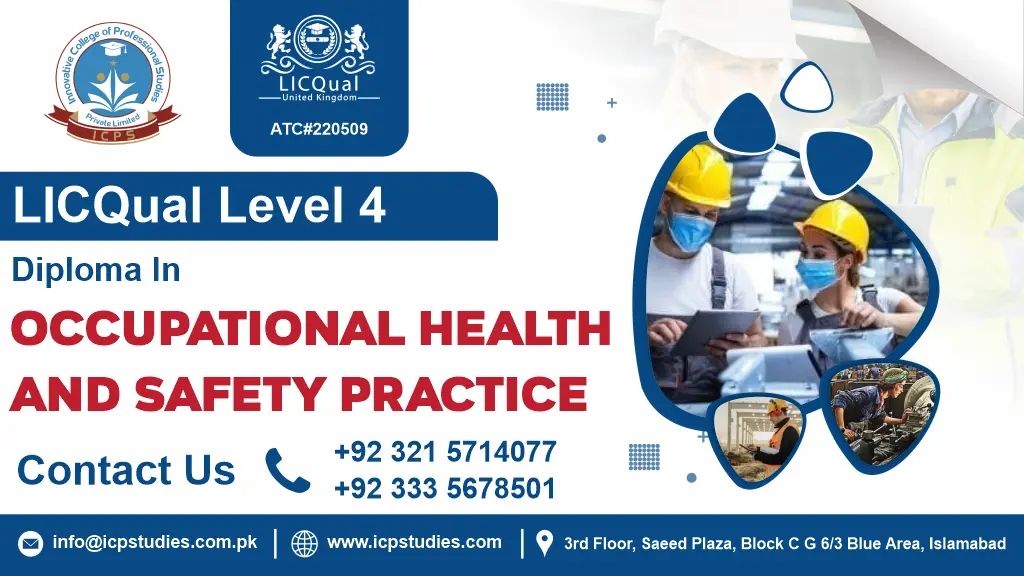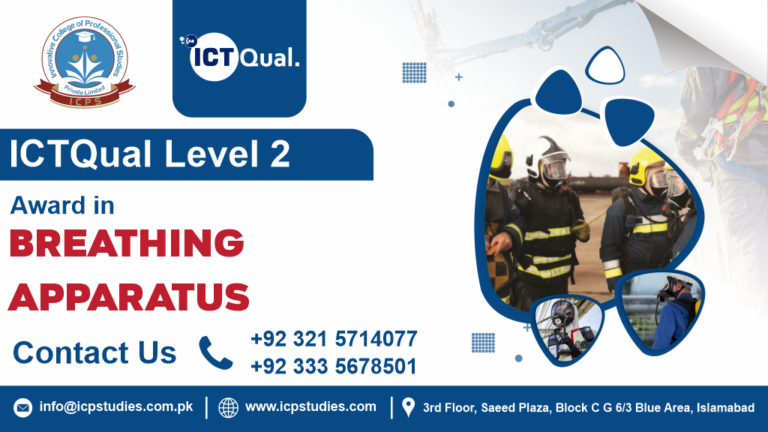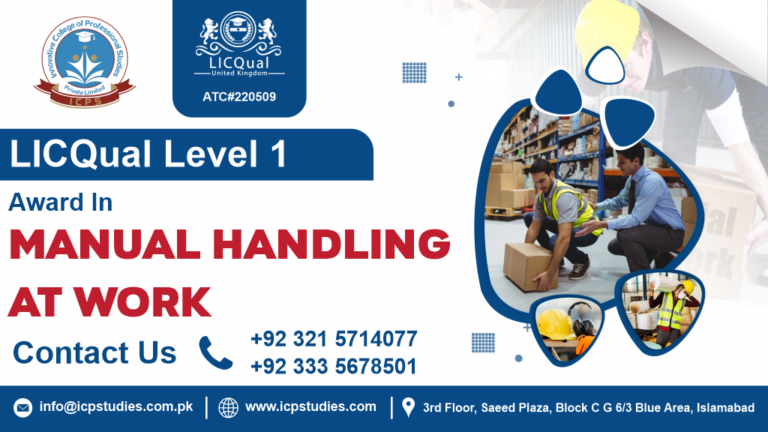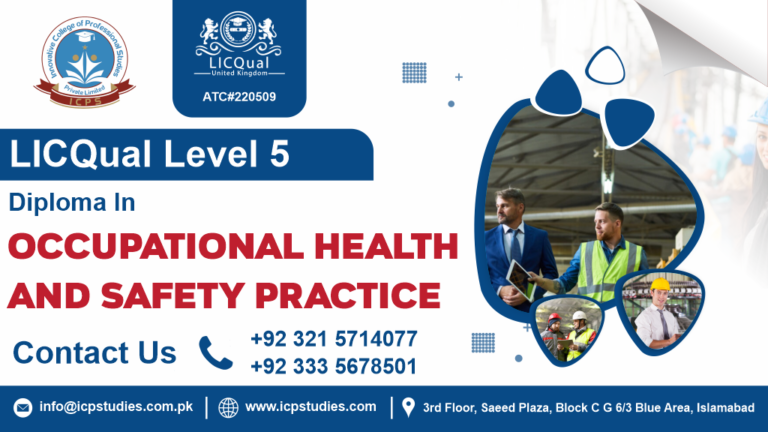LICQual is renowned for its commitment to excellence in education and training. With a track record of producing highly skilled professionals across various industries, LICQual certifications are trusted by employers worldwide. The Level 4 Diploma in Occupational Health and Safety Practice is no exception – it’s designed to provide you with the comprehensive knowledge and practical skills needed to excel in occupational health and safety management.
The diploma covers a wide range of topics essential for occupational health and safety practice, including risk assessment, hazard identification, accident investigation, emergency preparedness, and legal compliance. You’ll gain a deep understanding of relevant regulations, standards, and best practices.
Unlike some theoretical certifications, the diploma emphasizes practical application. You’ll have the opportunity to apply your knowledge in real-world scenarios through case studies, simulations, and hands-on exercises. This practical approach ensures that you’re well-prepared to tackle the challenges of occupational health and safety management.
LICQual certifications are recognized and respected by employers worldwide. Holding a Level 4 Diploma demonstrates your commitment to excellence in occupational health and safety practice and enhances your credibility in the eyes of employers. It opens doors to a wide range of career opportunities and advancement prospects.
In conclusion, the LICQual Level 4 Diploma in Occupational Health and Safety Practice is your pathway to success in occupational health and safety management. With its comprehensive curriculum, practical focus, and global recognition, the diploma equips you with the knowledge and skills needed to create safe, healthy, and productive workplaces. Don’t miss this opportunity to elevate your career – Enroll now in the Level 4 Diploma today and take the next step towards a brighter future.
All About Level 4 Diploma in Occupational Health and Safety Practice
Course Overview
The LICQual Level 4 Diploma in Occupational Health and Safety Practice is an advanced certification program designed to provide participants with the knowledge, skills, and practical expertise necessary to effectively manage occupational health and safety practices in the workplace. Developed by LICQual, a leading provider of education and training solutions, this diploma course is meticulously crafted to meet the evolving needs of modern workplaces and regulatory requirements.
The diploma covers a wide range of topics essential for occupational health and safety practice. Participants delve into areas such as risk assessment, hazard identification, accident investigation, emergency preparedness, legal compliance, and safety management systems.
Unlike some theoretical certifications, the diploma emphasizes practical application. Participants have the opportunity to apply their knowledge in real-world scenarios through case studies, simulations, practical exercises, and hands-on training. This practical approach ensures that graduates are well-prepared to address the challenges of occupational health and safety management.
LICQual certifications are recognized and respected by employers worldwide. Holding a Level 4 Diploma demonstrates a candidate’s commitment to excellence in occupational health and safety practice and enhances their credibility in the eyes of employers. This diploma is valued across various industries and opens doors to a wide range of career opportunities and advancement prospects.
In conclusion, the LICQual Level 4 Diploma in Occupational Health and Safety Practice is a prestigious certification program that equips participants with the knowledge, skills, and practical expertise needed to excel in occupational health and safety management. With its comprehensive curriculum, practical focus, and global recognition, this diploma course is the ideal choice for professionals looking to advance their careers in this critical field.
Study Units
Learning Outcomes
Here are the expected outcomes for each study unit:
- Promote a Positive Health and Safety Culture:
- Foster a workplace environment where health and safety are valued and prioritized by all employees.
- Cultivate a culture of accountability, responsibility, and continuous improvement in health and safety practices.
- Encourage open communication, active participation, and collaboration among employees to promote safety awareness and compliance.
- Develop and Implement the Health and Safety Policy:
- Create a comprehensive health and safety policy that aligns with organizational goals, regulatory requirements, and industry best practices.
- Ensure the health and safety policy is communicated effectively to all employees and stakeholders.
- Implement processes to review and update the health and safety policy regularly to reflect changes in legislation, standards, or organizational needs.
- Develop and Implement Effective Communication Systems for Health and Safety Information:
- Establish clear channels of communication for health and safety information within the organization.
- Develop protocols for disseminating important health and safety information to employees, contractors, and other relevant parties.
- Implement feedback mechanisms to ensure that health and safety concerns are addressed promptly and effectively.
- Develop and Maintain Individual and Organizational Competence in Health and Safety Matters:
- Provide training and development opportunities to enhance the health and safety knowledge and skills of employees at all levels.
- Develop competency frameworks and performance standards to assess and monitor individual and organizational competence in health and safety matters.
- Implement systems for recognizing and rewarding excellence in health and safety performance.
- Identify, Assess, and Control Health and Safety Risks:
- Identify potential health and safety hazards in the workplace through comprehensive risk assessments.
- Assess the likelihood and severity of risks associated with identified hazards.
- Implement control measures to eliminate or minimize health and safety risks, including engineering controls, administrative controls, and personal protective equipment (PPE).
- Develop and Implement Proactive Monitoring Systems for Health and Safety:
- Establish proactive monitoring systems to identify trends, patterns, and areas for improvement in health and safety performance.
- Implement regular inspections, audits, and observations to assess compliance with health and safety policies and procedures.
- Analyze monitoring data to identify root causes of health and safety issues and implement corrective actions.
- Develop and Implement Reactive Monitoring Systems for Health and Safety:
- Develop protocols for responding to incidents, accidents, near misses, and other health and safety emergencies.
- Implement procedures for investigating incidents to determine root causes and prevent recurrence.
- Establish systems for reporting and recording incidents, including documentation of corrective actions taken.
- Develop and Implement Health and Safety Emergency Response Systems and Procedures:
- Develop comprehensive emergency response plans and procedures for various health and safety scenarios, including fires, chemical spills, medical emergencies, and natural disasters.
- Train employees on emergency response protocols and procedures, including evacuation routes, emergency contacts, and communication protocols.
- Conduct regular drills and exercises to test the effectiveness of emergency response systems and procedures and identify areas for improvement.
Admission Criteria
Entry requirements for the course focusing on Occupational Health and Safety Practice typically include:
- Educational Background: Candidates are often required to have a high school diploma or equivalent qualification. Some institutions may prefer candidates with a background in science, engineering, or a related field due to the technical nature of the course content.
- Work Experience: While not always mandatory, relevant work experience in occupational health and safety, construction, industrial hygiene, or a related field may be advantageous. Many institutions offer courses tailored to professionals already working in these industries who seek to enhance their skills and knowledge.
- Language Proficiency: Candidates should have a proficient level of communication skills in the language of instruction, usually English. If the course is offered in a language other than the candidate’s native language, proof of language proficiency may be required, such as a standardized language test score.
- Prerequisites: Some institutions may require candidates to have completed certain prerequisite courses or certifications related to occupational health and safety, such as basic first aid training or an introductory course in health and safety principles. These prerequisites ensure that candidates have foundational knowledge before enrolling in more advanced courses.
- Health and Fitness: Depending on the nature of the course, candidates may need to meet specific health and fitness requirements. Occupational health and safety practice often involves physical activities and potential exposure to hazards, so candidates should be physically fit and able to meet the demands of the job.
- Legal Requirements: Candidates should ensure they meet any legal requirements set forth by regulatory bodies or government agencies in their region or country. This may include background checks, health screenings, or other regulatory requirements specific to the industry.
- Age Requirement: Candidates are typically required to be at least 18 years old to enroll in courses focusing on occupational health and safety practice due to the nature of the work and legal requirements.
It’s important for prospective candidates to review the specific entry requirements outlined by the institution offering the course, as these may vary. Additionally, candidates should consider any additional prerequisites or recommendations provided by the institution to ensure they are adequately prepared for the course.
Ideal Candidate
This course is suitable for a diverse range of professionals, including:
- Occupational Health and Safety Practitioners: Individuals already working in the field of occupational health and safety who seek to enhance their knowledge, skills, and qualifications. This course provides an opportunity for practitioners to stay updated with industry best practices and advancements.
- Safety Officers and Managers: Professionals responsible for developing, implementing, and monitoring occupational health and safety policies and procedures within organizations. This course equips safety officers and managers with the necessary expertise to effectively manage workplace safety initiatives.
- Health and Safety Consultants: Consultants who provide advisory services to organizations on occupational health and safety matters. This course enhances consultants’ credibility and expertise, enabling them to deliver comprehensive and effective solutions to clients.
- Human Resources Professionals: HR professionals involved in employee health and safety, risk management, and compliance within organizations. This course provides HR professionals with the knowledge and skills to ensure workplace safety and regulatory compliance.
- Facility Managers: Individuals responsible for managing facilities and infrastructure within organizations, including safety protocols and emergency preparedness. This course equips facility managers with the necessary tools to create and maintain safe working environments.
- Construction and Industrial Workers: Individuals working in construction, manufacturing, and industrial sectors where occupational hazards are prevalent. This course provides workers with essential knowledge and skills to identify and mitigate workplace risks, ensuring their safety on the job.
- Environmental Health Officers: Professionals responsible for inspecting and enforcing health and safety regulations in workplaces, public spaces, and communities. This course enhances officers’ understanding of occupational health and safety principles, enabling them to carry out their duties effectively.
- Students and Recent Graduates: Individuals pursuing a career in occupational health and safety or related fields. This course provides students with foundational knowledge and practical skills essential for entering the workforce and building a successful career in occupational health and safety.
Overall, this course is ideal for anyone committed to promoting a culture of safety, health, and well-being in the workplace and making a positive impact on the lives of workers. Whether you’re already working in the field or aspiring to do so, this course equips you with the expertise needed to succeed in occupational health and safety practice.
FAQs about Level 4 Diploma in Occupational Health and Safety Practice







